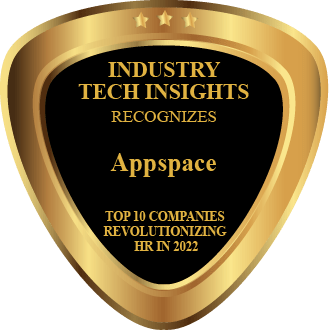
- December 13, 2025 9:24 pm
- California

According to an article by Holly Grogan Chief People Officer, Appspace, most HR leaders and company executives have been poring over industry-wide research about new work models for nearly three years now. Many of the employee-based surveys share similar findings to a recent Gallup survey of more than 8,000 remote-capable employees. In this survey, 71 percent responded that hybrid work improved their work-life balance, with 58 percent responding they experienced less burnout and fatigue. The Gallup research also pointed to some of the challenges of hybrid work, including impaired collaboration and relationships.
Industry research is a great tool in analyzing broader trends by vertical markets and other key demographics – especially when combined with feedback from our own team members. While research shows the “future” of work is here, our teams have shared how their workplace expectations are changing too. To keep up with employee expectations is a strategic business imperative and, for many organizations, starts with creating open door environments in which all team members can freely voice their ideas, regardless of where their workplaces may be.
Organizations have various options and paths forward in creating environments where employees feel free to share their expectations, ideas, and concerns without real or perceived barriers. Oftentimes, small policy and communications updates can positively impact employee perception and morale. Here are three additional steps companies may consider to create more meaningful conversations and generate continuous and actionable feedback for HR teams.
It’s about time and technology
According to the Appspace 2022 Digital Workplace Trends and Insights Report, employee expectations are outpacing organizational standards. With this in mind, employers must be strategic in how they communicate with employees, realizing that company transparency is key to employee engagement.
While providing less information isn’t always necessarily a better approach, employees usually appreciate conciseness and clarity when it comes to receiving company information. Many large and burgeoning companies outgrow the traditional approaches of connecting and informing teams. Digital tools help in these scenarios, delivering the right information in the most appropriate way.
Companies can choose and apply what technology works best.
For instance, digital signage may be the best channel to inform employees of upcoming activities, while an employee app may be a better option to communicate policy changes.
Going beyond formal town halls
While formal gatherings like town halls bring teams and leadership together to collaborate on important issues, the conventionality might hold back employees from being candid. Less formal settings may open the door to more honest interactions, while removing unnecessary hierarchy.
At Appspace, for example, we complement town halls with all-hands meetings. These less formal meetings focus on a specific area, like company strategy or product roadmap. We encourage team members to submit questions in advance, during, and immediately following these meetings – always giving them the opportunity to submit questions anonymously. We also take pulse surveys following both our all-hands and town hall meetings for insights into what employees like and, as important, what we can do better.
One Act at a Time
Small acts matter, so rewards and recognition can go a long way in creating environments where employees feel heard. Thanks to technology, there are feedback tools like the pulse surveys, polls, and forms that seamlessly capture the ins-and-outs of the everyday employee experience and how these intricacies impact employee expectations.
Long periods of working away from offices may cause some employees to feel disconnected and, as such, less likely to share their ideas and opinions. Ideal hybrid work environments should strive to fill the voids left by in-person interaction and provide employees with the workplace experience they need to perform their best. This also means organizations need to be more mindful and proactive in listening to employees’ suggestions and concerns to arrive at timely, actionable solutions that keep ideas flowing and engagement high.
Relying on Various Measures
HR leaders across every industry can attest that the biggest challenge in a remote working world is maintaining employee engagement. Of course, if employees feel connected to their colleagues and engaged by their work, they’re more likely to stay and thrive at the company.
Appspace, a Dallas-based HR tech firm with offices around the world, relies upon various measures to build and maintain engagement amongst its dispersed workforce. Unlike most companies, Appspace has had a leg up during the COVID-19 pandemic because it has allowed employees to work from home since the firm’s inception 20 years ago. “Our people were used to the rhythm of working remotely,” Holly Grogan, chief people officer at Appspace, told HRD.
Grogan says the company’s “aha” moment regarding employee engagement in a hybrid world was internal communications, crediting Lauren Patton – Appspace’s first dedicated internal comms leader – with creating strategies, consistent avenues for communication and transparent messaging to keep employees on the same page. Patton led the launch of Appspace’s first corporate intranet and oversees the distribution of weekly newsletters. The intranet hosts online communities for cooking, pets and other hobbies, inviting employees to share pictures and ideas.
Meanwhile, the weekly newsletter informs employees on what’s going on in the different areas of the business. The newsletter is accessible in different forms, such as the employee app, Slack and email. “Engagement is about meeting people where they are instead of trying to pull them to you,” Grogan says. “Say the same thing multiple times in multiple ways, so that you can get to people when they’re ready to digest information how they want.”
Meetings are also an important aspect of Appspace’s internal communications strategy. Grogan says there are hour-long town halls, which give business updates and announcements, and all-hands meetings, which are capped at 30 minutes and centered on a particular topic. Both virtual gatherings (which average about 65% attendance, Grogan says) end with a Q&A that helps company leaders learn what’s on employees’ minds. Following each meeting, a survey is sent out to solicit feedback, which the company has used to make changes, such as featuring more product discussion and slimming down the agenda to allow for sufficient time for the Q&A.
“The only thing companies can do when it comes to connecting with talent is to really listen,” Grogan says. “You think you know what people want and need, but if you stop, ask the question and listen, you may learn something.”
Traditionally, employee resource groups (ERGs) are influential in boosting employee engagement. ERGs consist of employees who volunteer their time and effort to foster an inclusive workplace. They’ve become commonplace since the racial protests throughout the United States in the summer of 2020. Due to their motivations, needs and the general nature of ERG work, employees who lead these groups are more likely to be Black, Indigenous and People of Color (BIPOC) and oftentimes women. ERGs are a way for underrepresented groups to band together to recruit more talent like them into their companies and make sure that talent feels supported and gets promoted.
According to Grogan, Appspace has a diversity and inclusion team that’s less structured like an ERG and more like a pillar of the business, working closely with the HR team. “They’re the vision and ideas behind what we want to do as an organization and HR is the muscle for their ideas,” Grogan says. “When you think about inclusion, that should be part of what defines your culture. It should be systemic and what you live. We’re in the process of setting up different chapters in different regions because the issues and concerns in the U.S. are different from the issues and concerns around the globe.”
Appspace’s HR team also measures its Employee Net Promoter Score through monthly pulse sampling and then annually. To gauge how employees are connected to the company, the team analyzes meeting attendance, newsletter click-through rate, attrition rate, mobility within the organization and other factors.
“Empathy has become a critical business skill,” Grogan says. “All of us as teammates and colleagues must be able to think about what somebody else is going through, so we can connect with them. In this hybrid world, our home is no longer about our friends and family – it’s for our colleagues, too. You need to have empathy so you can check in on people. That creates connection.”
Embracing Change
Tony DiBenedetto, CEO, Appspace says in an article in HTC, Appspace celebrated its 20th anniversary in July, an accomplishment the founders, Brandon Miles and Stan Stephans, are extremely proud of.
The company’s beginnings were in digital signage – primarily helping Fortune 500 companies engage employees and visitors in their lobbies, meeting spaces, and breakrooms.
Through product innovation and acquisitions, Appspace now offers the only unified workplace experience platform to manage workplace communications and workplace management. Our platform combines a modern intranet, space reservation, employee app, and, of course, digital signage.
This helps our customers embrace hybrid, in-person, and remote workplace models without using a lot of different point solutions or their employees using multiple apps. We have more than 400 employees in North America, the U.K. Malaysia, and Australia who help the company fulfill our mission of creating workplaces employees love. Our People & Culture team makes sure we, as a company, live up to that mission too.
Our unified platform differentiates Appspace. We make it easier for companies to engage employees whether it’s through a modern intranet, digital signage, or employee app. This is important as IT departments don’t want to manage a lot of point solutions for workplace communications.
Appspace also recently launched Appspace for Microsoft, which connects Microsoft Teams, SharePoint and Viva with modern intranet and employee app solutions. Organizations now can extend Microsoft’s solutions, allowing employees with easy options to manage everyday workplace tasks like finding and reserving the right room or desk inside Microsoft Outlook.
Before becoming CEO of Appspace, I was on the Appspace Board for two years. I was an active Board member, keeping an eye on growth opportunities and product innovation. As the company scales, I’ll continue to work with sales, product, and customer success to make sure we’re keeping customers happy and expanding our relationships by delivering value.
I’ll also work more closely with the People and Culture team to support their efforts in building the best workplace possible. Some philosopher once said, “the only thing constant in life is change.” While some leaders are fighting workplace change tooth and nail, I see an opportunity to create a better workplace – regardless of where that place is.
As CEO of Appspace, I’m excited our technology can play a major role in helping customers more easily adapt to new workplace dynamics. On a personal level, I’m also excited our new way of working allows me to regularly connect and engage with team members around the world. I’m in Florida, but appreciate the diversity of thought and backgrounds I get from working with people in Spain, Canada, or Kuala Lumpur, as examples. My previous company, Tribridge, had multiple offices, so I’m used to a global model. But, technology like Appspace, is making cross-team collaboration so much easier than it was back in the day.
Appspace will become even more global in our product focus and with our teams – a true reflection of how our enterprise customers operate and what they expect from their technology partners.
As a workplace experience platform, Appspace has a lot of opportunity to help corporations and other organizations deliver a better, more engaged experience to their employees – and we will continue to meet that bigger need through continuous product innovation and partnerships, like Microsoft and Google.

" Our platform combines a modern intranet, space reservation, employee app, and, of course, digital signage. "
Tony DiBenedetto
CEO
Appspace